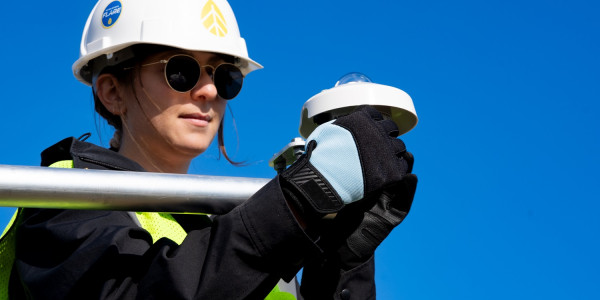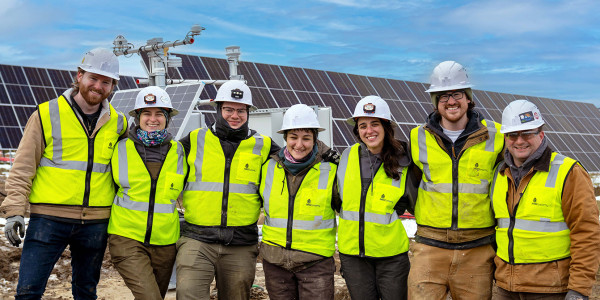December 30, 2011 | Sustainability + Energy,
Larry Gibson is an environmental hero. He didn’t ask for the “job” of bringing attention to the Appalachian tragedy of mountaintop removal. It came to him, his family, his backyard. It came to his mountain in West Virginia. And now, talking to others about the harsh realities of mountaintop removal is his life’s mission.
I met Larry this past spring while visiting the Appalachian area following an American Wind Wildlife Institute board meeting in Washington DC. Instead of doing a flyover of coal country on that particular day, bad weather allowed me and my colleague to spend several hours with Larry at his home on Kayford Mountain.
Kayford Mountain: An island in a sea of destruction
Larry’s family has owned land on or near Kayford Mountain since the late 1700s—more than 300 years. More than 300 of his relatives are buried in the cemetery on Kayford Mountain. (The family cemetery is now behind a locked gate controlled by the coal company. Larry must complete paperwork each time he comes to the gate so he can visit his family cemetery.)
Driving up to Larry’s property we saw a seemingly endless stream of train cars overflowing with coal. The road that winds its way up to Larry’s property is maintained by the coal company. They must keep it open because Larry still owns property on the mountain.
When we arrived at Larry’s property, we saw a small house, various outbuildings and a pavilion with picnic tables. (Larry shares his property with children, families, and others who are interested in learning about mountaintop removal.) His house is now protected by a solar-powered alarm system. He no longer lives there full-time because he feels it would not be safe for him to do so.
There are still trees and grass on Larry’s property—it’s like a little oasis in this vast area of destruction. Standing on Larry’s property there are no obvious signs of mountaintop removal. But I soon learned that the steep and rugged terrain provides the perfect hiding place for the coal industry’s work.
Larry led us up a pristine wooded path in front of his house. At the end of the path we came to a berm and climbed on top. It’s not until you step up there that you realize the other half of the mountain is entirely gone—blasted away.
Now it’s clear to see that Kayford Mountain is an active mountaintop removal site with heavy equipment, machinery and construction signs. Looking down from above it looks somewhat like the surface of the moon—an ugly dusty expanse. You can see tiered rings that represent the many layers of earth that have been removed to get at the seams of coal. It’s a shocking site and never did I anticipate just how disturbing it would be.
Then Larry shared the story of how Kayford Mountain used to be.
Thriving communities gone
Larry told us about the thriving community that once existed on Kayford Mountain. It’s hard to imagine now as only a few homes remain standing. But Larry explained that once there were more homes, a church, and dozens of stores. It was an isolated, but self-sufficient community as many are in the Appalachians. These people lived on the mountains, part of a balanced eco-system that provided everything they needed to live.
Mountaintop removal has changed all that. The bulldozers, blasting and heavy machinery of the coal industry have destroyed the eco-systems on these mountains and, in the process, destroyed families and their way of life…forever.
Larry explained that mountaintop removal divided families. And he knows this all too well. On Kayford Mountain, not everyone refused to sell to the coal company. People were at odds with one another. They were faced with an impossible choice: stay in an area that could no longer provide them with a livelihood or leave a home that’s been in their family for years and try to start over somewhere else.
At one time, Larry’s family property was on the lowest lying part of the mountain. They looked up to the mountain peaks that surrounded their family property. Larry now owns the highest point of land around. He is surrounded by more than 7,500 acres of destruction—what used to be beautiful forested mountains. He is essentially a 50-acre island on top of a ridgeline that no longer exists. (Larry has put the 50 acres in a land conservancy.)
Helping our Appalachian neighbors
I think about the plight of the Appalachian families and it weighs heavy on me. I’m deeply concerned about the impacts that mountaintop removal has on our water, our soils, our children and our wildlife habitat. The impacts are real, destructive and life-changing for many—we simply cannot afford to ignore them.
Larry is pleading for our help. He has devoted his life to meeting with people to tell the story. He doesn’t feel the people of Appalachia have had a voice in this process. They’ve been overpowered by machinery, the powerful coal industry lobbyists and even the politicians who are supposed to help our citizens.
There is no doubt Larry has suffered through all this. But he doesn’t consider himself a victim. He calls himself a survivor. And he knows that just like the mountains around his property, he won’t last forever.
Take a look at the resources here. Learn about this issue and the many ways you can get involved. Let’s lend our voices to our Appalachian neighbors and help them in this fight.
Additional resources:
Larry Gibson at Kayford Mountain, YouTube video
MTR Visit with Larry Gibson -- Pick Up America, YouTube video
Strange as this weather has been, a novel by Ann Pancake





